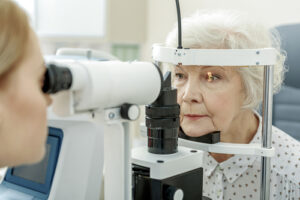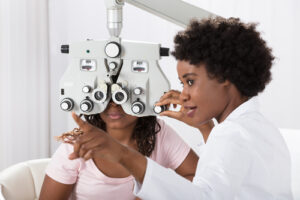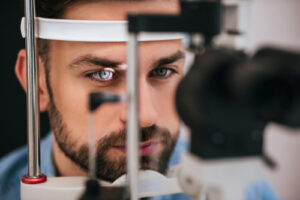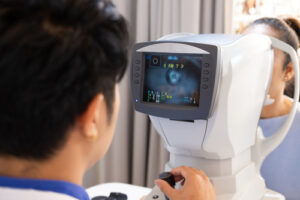What Happens During a Routine Eye Exam?
No matter your age, background, or whether you wear glasses or contacts, routine eye exams are vital. They allow you to stay on top of your eye health and check that you are seeing the world with clarity.
Eye exams are often associated with reading a chart of letters, but they involve much more than that. Eye exams are comprehensive tools for evaluating your eyes and vision.
For this reason, you can expect a typical eye exam to take between thirty minutes and an hour to complete. Would you like to know what your next eye exam will be like?
Keep reading to find out what happens during a routine eye exam!
What Information Should I Bring to My Eye Exam?
Before you arrive at our office, it’s important to think about what information you will need to share with your eye doctor. They will need a full picture of both your eye health history and your overall health.
 At the start of your exam, your eye doctor will ask you about any existing health issues. It is important to tell them about any conditions you may have, such as diabetes and hypertension, because they can have an impact on your eyes.
At the start of your exam, your eye doctor will ask you about any existing health issues. It is important to tell them about any conditions you may have, such as diabetes and hypertension, because they can have an impact on your eyes.
They will need to be aware of any medications you are taking, so be sure to compile a list of them. Your eye doctor will also ask you about the medical history of your family.
Some conditions, such as glaucoma and optic nerve disorders, can run in families. If you have any concerns about your vision, this is a good time to relay them.
For example, you may have noticed that your eyes have been feeling dry lately or that your glasses aren’t working as well as they used to.
How Is Visual Acuity Assessed?
Visual acuity refers to the clarity of your vision. As many people are familiar, this is where you will be asked to read letters from an eye chart.
The letters decrease in size with every line, allowing your eye doctor to identify at which point you begin having trouble reading them accurately. A visual acuity test only takes a few minutes. 
You will cover one eye at a time to test each. For many people, the eye chart reveals some kind of limitation to their vision, whether nearsightedness, farsightedness, or astigmatism.
To identify the prescription you need, your eye doctor will then instruct you to sit in front of a phoropter machine. This part of the exam involves looking through lenses containing a range of prescription powers.
They will position different lenses in front of you and ask which is clearer until they can determine your prescription. This is also known as a refraction test.
Sometimes, an autorefractor is used. The eye is exposed to light, and the machine measures how well the eye can focus it.
Your peripheral vision can be easily measured by seeing how well your eyes can focus on an object as it travels across your field of vision. The doctor will check for any potential areas of vision loss.
Will My Pupils Be Dilated?
Dilation is a frequent occurrence for routine eye exams. They allow your eye doctor to get a better look at the many tiny structures of the eye. 
The eyes can be easily dilated with special eye drops. Once they are fully dilated, a device called a slit lamp may be used to view the eye.
This is like a microscope that shines a bright light into the eye. Your eye doctor will then closely examine your cornea, iris, lens, retina, optic nerve, and more.
The effects of dilation will begin to wear off within a few hours. It’s always a good idea to bring sunglasses to your appointment, because dilation makes your eyes very sensitive to light.
Will I Be Screened for Eye Conditions?
A key purpose of eye exams is to screen you for various eye diseases. Some conditions, such as glaucoma and cataracts, develop so gradually that you can have them and not be aware of them.

Your eye doctor will inspect the different structures of your eye to make sure there are no warning signs of disease. In addition, your eye doctor will evaluate how well your eye muscles are working.
Strabismus, also known as crossed eyes, and amblyopia, also known as lazy eye, are two conditions that involve the eye muscles. A tonometry test may be performed.
This measures your eye pressure using a puff of air. Tonometry is important because increased eye pressure is associated with glaucoma.
Close-up images may also be taken of your eye. Such images can be evaluated for signs of conditions affecting the optic nerve, cornea, and other structures.
Some non-ocular-specific conditions can affect the eyes. So, your doctor will also look for ways in which conditions such as diabetes, hypertension, and thyroid disease may be affecting the eyes.
What Happens Next?
Your eye doctor will discuss any treatment or next steps as appropriate. If they suspect you may have a condition, additional testing may be performed.
If you have a refractive error, the doctor will give you your new prescription or fit you for glasses or contacts. They can also discuss your permanent vision correction options if you are interested in seeing clearly without the need for visual aids.
Are you due for an eye exam? Schedule your next exam at Complete EyeCare West in Columbus, OH, today!







